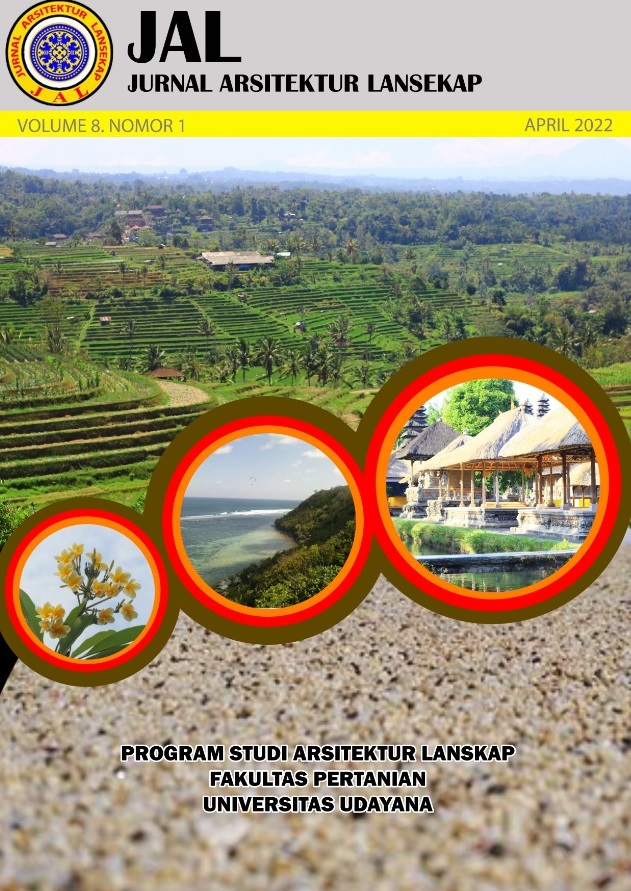Perencanaan Ruang Publik Berbasis Data Biofisik di Hulu Tukad Badung, Desa Sempidi, Kabupaten Badung
Abstract
Public space planning based on biophysic data of upper Tukad Badung, Sempidi Village, Badung District. The Upper Tukad Badung area has the potential for natural sceneries, ecological values and religious socio-culture areas to be developed as a comfortable and safe public zone. The purpose of this research is to identify, analyze the biophysical and social aspects and allocate space for public activities in accordance with the conditions of the Upper Tukad Badung area. The research method used was a survey method using data collection techniques through observation, site documentation, interviews, questionnaires, and literature study. The landscape planning stages included inventory, analysis, synthesis, and landscape planning. The results of spatial synthesis of topographic and vegetation data with descriptive analysis of other data resulted active and passive public zones. The zones were connected with primary and secondary circulation types in a linear pattern. The vegetation plan had three functions;aesthetic conservation, cultivation, and vegetation.
Downloads
References
Diena, A.L. (2009). Pengaruh Perubahan Penggunaan dan Penutupan Lahan Terhadap Kenyamanan di Suburban Bogor Barat. Skripsi. Program Studi Arsitektur Lanskap. [Fakultas Pertanian Institut Pertanian Bogor].
Hasriyanti, N., (2014). Kajian Ruang Publik Tepi Air. Jurnal Teknik Arsitektur Politeknik Negeri Pontianak, 10(1), p.21-26.
Republik Indonesia. (2001). Peraturan Pemerintah Nomor 82 Tahun 2001 Tentang: Pengelolaan Kualitas Air dan Pengendalian Pencemaran Air. Sekretariat Kabinet RI. Jakarta.
Soepraptohardjo. (1961). Tanah Merah di Indonesia. Bogor: Balai Besar Penjelidikan Pertanian.
Triantafyllidou,C. 2021. The 2015 Atles of Sustaineble Development Goals: Benefiting from Integrating Water into Public Spaces. Retrieved January 29, 2021, from https://iwa-network.org/benefiting-from-integrating-water-into-public-spaces/.

This work is licensed under a Creative Commons Attribution-ShareAlike 4.0 International License.
An author who publishes in the Jurnal Arsitektur Lansekap (JAL) agrees to the following terms:
- Author retains the copyright and grants the journal the right of first publication of the work simultaneously licensed under the Creative Commons Attribution-ShareAlike 4.0 License that allows others to share the work with an acknowledgement of the work's authorship and initial publication in this journal
- Author is able to enter into separate, additional contractual arrangements for the non-exclusive distribution of the journal's published version of the work (e.g., post it to an institutional repository or publish it in a book) with the acknowledgement of its initial publication in this journal.
- Author is permitted and encouraged to post his/her work online (e.g., in institutional repositories or on their website) prior to and during the submission process, as it can lead to productive exchanges, as well as earlier and greater citation of the published work (See The Effect of Open Access).
Read more about the Creative Commons Attribution-ShareAlike 4.0 Licence here: https://creativecommons.org/licenses/by-sa/4.0/.







